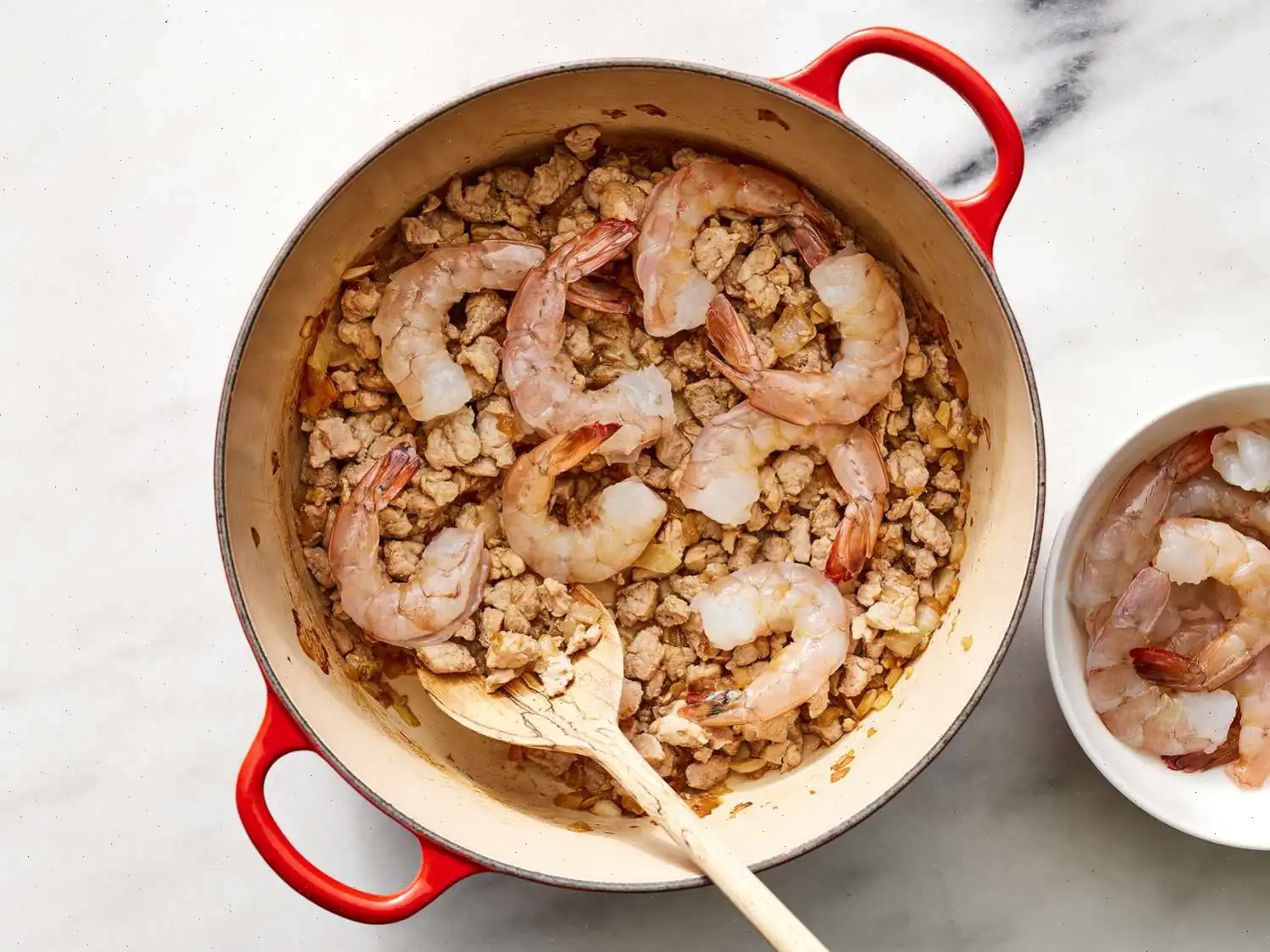
Pinakbet Recipe
This hearty and flavorful dish combines tender pork, succulent prawns, and a variety of fresh vegetables for a meal that's both satisfying and nutritious. Follow the steps below to make this tasty stew!
Ingredients (Serves 6)
- 3 tablespoons olive oil
- 1 onion, chopped
- 2 cloves garlic, minced
- pound pork loin, chopped
- pound peeled and deveined prawns
- Salt and pepper, to taste
- 1 tomato, chopped
- pound zucchini, seeded and cut into bite-size pieces
- pound fresh okra, ends trimmed
- pound fresh green beans, trimmed
- pound eggplant, cut into bite-size pieces
- 1 small bitter melon, cut into bite-size pieces
Directions
Step 1: Heat the olive oil in a large pot over medium heat. Once the oil is hot, add the chopped onion and minced garlic. Saut for about 5 minutes, or until the onion becomes tender and translucent.
Step 2: Add the chopped pork loin to the pot. Cook, stirring occasionally, until the pork is browned, about 5 to 7 minutes.
Step 3: Add the prawns to the pot. Stir and cook for another 5 minutes, or until the prawns turn pink and are cooked through.
Step 4: Stir in the chopped tomato, then season with salt and pepper to taste. Cover the pot and let it simmer for 5 minutes.
Step 5: Add the zucchini, okra, green beans, eggplant, and bitter melon to the pot. Stir everything together, cover, and let the vegetables cook until they are tender, about 10 minutes.
Once the vegetables are tender, give the stew one last stir and check the seasoning. Serve hot, and enjoy your delicious stew!
Nutrition Facts (per serving)
| Calories | 184 |
| Total Fat | 10g |
| Saturated Fat | 2g |
| Cholesterol | 75mg |
| Sodium | 111mg |
| Total Carbohydrate | 9g |
| Dietary Fiber | 3g |
| Total Sugars | 4g |
| Protein | 14g |
| Vitamin C | 23mg |
| Calcium | 56mg |
| Iron | 2mg |
| Potassium | 445mg |
* Percent Daily Values are based on a 2,000 calorie diet. Your daily values may be higher or lower depending on your calorie needs.

Pinakbet is a quintessential Filipino dish that perfectly combines a variety of fresh vegetables, pork, and prawns. It is both nutritious and flavorful, often enjoyed as a hearty one-pot meal. The origins of this beloved dish trace back to the rural provinces of the Philippines, where it was initially created as a way to make use of the bountiful harvest of vegetables. Below, we delve into the rich history, regional variations, and unique qualities of Pinakbet that set it apart from other similar dishes.
History of Pinakbet
Pinakbet's roots are deeply intertwined with the agricultural lifestyle of the Filipino people. The word "Pinakbet" comes from the Ilocano term "pinakebbet," which means "shrunk" or "simmered." The dish traditionally uses a variety of local vegetables that are cooked down in a savory broth. Pinakbet was originally a dish made by the Ilocano people of Northern Luzon, one of the Philippines' major islands. In the past, it was made primarily with vegetables from the land such as bitter melon, eggplant, okra, and string beans, often paired with fermented shrimp paste or fish sauce to enhance the flavor. Over time, different regions have put their own spin on the dish, making it an integral part of Filipino cuisine.
Regional Variations of Pinakbet
Though Pinakbet is a staple throughout the Philippines, its preparation varies depending on the region. The Ilocanos are credited with the creation of the dish, but in different parts of the country, ingredients and cooking methods may change. In the Ilocos region, the dish is often cooked with bagoong (fermented shrimp paste), which is a signature ingredient in many Ilocano recipes. In contrast, other regions may use fish sauce or add other types of proteins, such as beef or chicken, instead of the traditional pork and shrimp. Additionally, some versions of Pinakbet use a tomato-based broth, while others may cook it in a more savory, salty broth. The level of bitterness from the bitter melon can also vary based on local preferences, with some opting for a milder taste by removing the seeds and others embracing the natural bitterness.
Differences from Similar Dishes
Pinakbet stands out from other vegetable-based Filipino dishes like "Laing" and "Sinigang" due to its distinctive combination of vegetables and its emphasis on umami flavors from fermented shrimp paste or fish sauce. While "Laing" primarily features dried taro leaves in a rich coconut milk base, and "Sinigang" is a sour, tamarind-based soup, Pinakbet is a hearty, savory vegetable stew with pork and prawns. What sets Pinakbet apart is its balance of flavorsbitterness from bitter melon, sweetness from tomatoes, and the richness of pork, combined with the umami from shrimp paste or fish sauce. Additionally, while Sinigang often relies on a sour base and Laing uses coconut milk, Pinakbet is purely vegetable-driven, with less reliance on cream or acidity.
Where Pinakbet Is Usually Served
Pinakbet is commonly served in Filipino households, especially during family gatherings, celebrations, and everyday meals. It is often paired with steamed rice, making it a filling and complete meal. This dish is also commonly found in Filipino restaurants both in the Philippines and abroad, where it is served as part of a "ulam" (main dish) spread alongside rice and other traditional Filipino side dishes. Pinakbet is especially popular in rural areas where vegetables are in abundance, and it remains a comfort food for many. Its a dish that brings people together, often passed around the table in large communal servings.
Interesting Facts About Pinakbet
- Pinakbet is considered a healthy and nutrient-rich dish due to its wide variety of vegetables, which include zucchini, eggplant, okra, green beans, and bitter melon. These ingredients are packed with vitamins, minerals, and fiber.
- The addition of fermented shrimp paste or fish sauce not only enhances the flavor but also reflects the Filipino love for fermented products, which play a crucial role in the countrys culinary heritage.
- In some regions, the bitterness of the bitter melon is considered a key characteristic of Pinakbet, and the dish is seen as a "bitter" reminder of the value of patience and resilience in Filipino culture.
- Pinakbet's appeal lies in its versatilityhome cooks can swap vegetables and proteins based on availability and personal preferences, making it an adaptable dish for various dietary needs.
- While pork and prawns are traditional, there are vegetarian versions of Pinakbet that exclude the meat and seafood, relying solely on vegetables like squash and mushrooms to deliver a rich, hearty meal.
Conclusion
Pinakbet is more than just a dish; its a reflection of Filipino history, culture, and values. Its humble beginnings in the rural regions of the Philippines have led to its widespread popularity throughout the country and beyond. With its rich flavors, nutritional benefits, and adaptability, Pinakbet remains a staple in Filipino kitchens worldwide, bringing comfort and satisfaction to anyone lucky enough to enjoy it.
FAQ about Pinakbet Recipe
Comments
Debra Wright
06/02/2023 05:46:32 AM
Great Filipino recipe that my mother often cooks.
Jacob Williams
08/24/2024 11:54:30 AM
I used a 12-can pack of V-8 tomato juice and cooked it in the slow cooker for about 4 hours. The seasonings in the V-8 really enhanced the flavor and made it delicious!
Jessica Nelson
08/22/2023 11:58:41 PM
Rewritten review: I didn't have any bitter melon or okra, so I substituted chicken for pork. Additionally, I enhanced the dish with vegetable bouillon, red pepper flakes, cilantro, creole seasoning, and a cup of water thickened with corn starch. The result was incredibly delicious! My daughter absolutely enjoyed it as well. I will definitely be making this recipe again.
Catherine Phillips
10/16/2022 08:01:20 AM
This was excellent! I decided to grow bitter melon in my garden, but not knowing how to prepare it led me to try this recipe. I will definitely be making it again!
Victoria Hall
09/17/2024 04:13:23 PM
I substituted chicken for pork since that's what I had available. The dish was enjoyable, especially with all the vegetables, but I felt it lacked some extra flavor.
Dennis Martin
10/17/2023 12:52:27 PM
A friend gifted me some bitter melon, and I had no clue how to prepare it. Luckily, I stumbled upon this recipe which utilized ingredients from my garden. I didn't have prawns, so I skipped that part. I did include a small fresh cayenne pepper for some heat. While it was a bit too mild for our taste, it turned out fantastic. There wasn't a single bite left, and I'll definitely be making this again!












